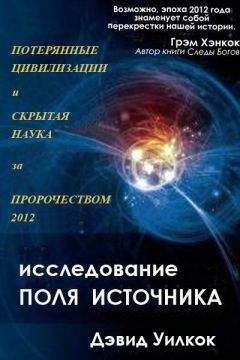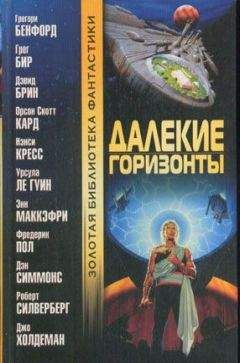Дэвид Уилкок - Исследования поля источника

Помощь проекту
Исследования поля источника читать книгу онлайн
Morton, Carol. “Scientists find solar system’s hottest surfaces on Jupiter’s moon Io.” NASA/The Brown University News Bureau, July 2, 1998. http://www.brown.edu/Administration/News_Bureau/1998-99/98-001.html
877
“PIA01637:Io’s Aurorae.” NASA/JPL Planetary Photojournal, October 13, 1998. http://photojournal.jpl.nasa.gov/catalog/PIA01637
878
Porco, Carolyn, et al. “Cassini Imaging of Jupiter’s Atmosphere, Satellites and Rings.” Science, 299 (5612) 1541–1547, March 7, 2003. http://www.scencemag.org/content/299/5612/1541/suppl/DC1
879
Russell, C.T., et al. “Io’s Interaction with Jovian Magnetosphere.” Eos, Transactions, American Geophysical Union, Vol. 78, No. 9 (1997), pp. 93, 100. http://www-ssc.igpp.ucla.edu/personnel/russell/papers/Io_Jovian/
880
Saur, Joachim, et al. “Jupiter: The Planet, Satellites and Magnetosphere, Chapter 22: Plasma Interaction of Io with its Plasma Torus.” http://dosxx.colorado.edu/JUPITER/PDFS/Ch22.pdf
881
Schneider, N.M., et al. “Substantial Io Torus Variability 1998–2000.” NASA Planetary Astronomy Program, DPS 2001 meeting, November 2001. http://aas.org/archives/BAAS/v33n3/dps2001/513.htm?q=publications/baas/v33n3/dps2001/513.htm
882
Buckley, Michael, et al. “Johns Hopkins Applied Physics Lab Researchers Discover Massive Gas Cloud Around Jupiter.” JHU Applied Physics Laboratory, February 27, 2003. http://www.jhuapl.edu/newscenter.pressreleases/2003/030227.asp
883
McGrath, Melissa, et al. “Jupiter: The Planet, Satellites and Magnetosphere, Chapter 19: Satellite Atmospheres.” http://dosxx.colorado.edu/JUPITER/PDFS/Ch19.pdf
Сейчас эта страница не существует.
См. http://books.google.ru/books?id=aMERHqj9ivcC&pg=PA457&lpg=PA457&dq=McGrath,+Melissa,+et+al.+%E2%80%9CJupiter:+The+Planet,+Satellites+and+Magnetosphere&source=bl&ots=TXoj7bQo8c&sig=NolGUIgQ_l53E5D1kW4URKwySSk&hl=ru&sa=X&ei=5qVDT-u9M4jh4QT765mlCA&ved=0CDMQ6AEwAg#v=onepage&q=McGrath%2C%20Melissa%2C%20et%20al.%20%E2%80%9CJupiter%3A%20The%20Planet%2C%20Satellites%20and%20Magnetosphere&f=false
А также Юпитер: строение, космические данные, спутники и атмосфера http://moikompas.ru/compas/jupiter
884
Там же
885
Там же
886
Stenger, Richard. “New revelations, riddles about solar system’s most intriguing satellites.” CNN.com/Space, August 23, 2000. http://archives.cnn.com/2000/TECH/space/08/23/moons.of.mystery/index.html
887
McGrath, Melissa, et al. “Jupiter: The Planet, Satellites and Magnetosphere, Chapter 19: Satellite Atmospheres.” Сочинение цитированное
888
Platt, Jane. “New Class of Dust Ring Discovered Around Jupiter.” NASA/JPL Press Release, April 3, 1998. http://www.jpl.nasa.gov/releases/98/glring.html
889
Merali, Zeeya. “Milky Way’s two stellar halos have opposing spins.” NewScientist.com, December 12, 2007. http://space.new3sscientist.com/article/dn13043-milky-ways-two-stellar-halos-have-opposing-spins.html
890
Sittler, Ed, et al. “Pickup Ions at Dione and Enceladus: Cassini Plasma Spectrometer Simulations.” NASA/Goddard Space Flight Center/Journal of Geophysical Research, Vol. 109: January 20, 2004. http://caps.space.swri.edu/caps/publications/Sittler.pdf
891
Trauger, J.T., et al. “Hubble Provides the First Images of Saturn’s Aurorae.” HubbleSite NewsCenter, October 10, 1995, no. 39.
http://hubblesite.org/newscenter/newsdesk/archive/releases/1995/39 http://hubblesite/org/newscenter/newsdesk/archivereleases/1998/05/
892
“Mysterious glowing aurorae over Saturn confounds scientists.” Mail Online, November 13, 2008. http://www.dailymaik.co.uk/sciencetech/article-1085354/Mysterious-glowing-aurora-Saturn-confounds-scientists.html
893
Hill, Mary Ann. “Saturn’s Equatorial Winds Decreasing: Spanish-American Team’s Findings Raise Question About Planet’s Atmosphere.” Wellesley College News Release, June 4, 2003. http://www.wellesley.edu/PublicAffairs/Releases/2003/060403.html
894
Roy, Steve and Watzke, Megan. “X-rays from Saturn pose puzzles.” NASA/Marshall Space Flight Center News Release #04-031, March 8, 2004. http://www.nasa.gov/centers/marshall/multimedia/photos/2004/photos04-031.html
895
“Overview: Saturn.” NASA Solar System Exploration. http://solarsystem.nasa.gov/planets/profile.cfm?Object=Saturn amp;Display=OverviewLong
896
Finn, Heidi. “Saturn Details Become Visible to Cassini Spacecraft.” NASA GISS Research News, December 5, 2003. http://ciclops.lpl.arizona.edu/PR/2003L05/NR2003L05A.html
897
Porco, Carolyn. “Approach to Saturn Begins.” Cassini Imaging Central Laboratory for Observations News Release. February 27, 2004. http://www.ciclops.org/ondex/54/Approach_to_Saturn-Begins
898
Associated Press. “Scientists Studying Saturn Lightning Storm.” February 15, 2006. http://web.archive.org/web/20060217224253 http://apnews.myway.com/article/20060215/D8FPC9KB.html
899
Harvard-Smithsonian Center for Astrophysics. “Titan Casts Revealing Shadow.” Chandra X-Ray Observatory Photo Album Web site of NASA/SAO. April 5, 2004. http://chandra.harvard.edu/photo/2004/titan/
900
“A dense, Hazy atmosphere at least 400 kilometers (250 miles) thick obscures the surface [1074]” In Woodfill, Jerry. The Satellites of Saturn: Titan. NASA JSC Space Educator’s Handbook, Last Updates February 11, 2000. http://web.archive.org/web/20060827091938/ http://vesuvius.jsc.nasa/gov/er/seh/satsaturn.html
901
Brown, Michael E., et al. “Direct detection of variable tropospheric clouds near Titan’s south pole.” Nature, December 2002. http://www.gps.caltech/edu/~mbrown/papers/ps/titan.pdf
902
Sittler, Ed, et al. “Pickup Ions at Dione and Enceladus: Cassini Plasma Spectrometer Simulations.” NASA/Goddard Space Flight Center/Journal of Geophysical Research, Vol. 109: January 20, 2004. http://caps.space.swri.edu/caps/publications/Sittler.pdf
903
Moskowitz, Clara. “Tropical Storm Spotted on Saturn’s Moon Titan.” LiveScience, August 12, 2009. http://livescience.com/space/090812-titan-clouds.html
904
NASA/Karkoschka, Erich, et al. “Huge Spring Storms Rouse Uranus from Winter Hibernation.” HubbleSite NewsCenter, March 29, 1999, no. 11. http://hubblesite.org/newscenter/archive/releases/1999/11/text/
905
881 Karkoschka, Erich, et al. “Hubble Finds Many Bright Clouds on Uranus.” HubbleSite Newscenter, October 14, 1998, no. 35. http://hubblesite/org/newscenter/archive/releases/1998/35/
906
NASA/Karkoschka, Erich, et al. “Huge Spring Storms Rouse Uranus from Winter Hibernation.” Сочинение цитированное
907
NASA. “Huge Hit the Planet Uranus.” [email protected] Web site, March 29,1999. http://science.nasa.gov/science-news/science-at-nasa/1999/act29mar99_1/
908
McLachlan, Sean. “UA scientists look closely at Uranus.” University of Arizona Daily Wildcat, March 30, 1999. http://wc.arizona.edu/papers/92/123/01_3_m.html
909
“1.29 Completed WF/PC-2 8634 (Atmospheric Variability on Uranus and Neptune.” Period Covered: 09/29/00-10/02/00. Hubble Space Telescope Daily Report # 2719. http:// www.stsci.edu/ftp/observing/status_reports/old_reports_00/hst_status_10_02_00
910
Sromovsky, Lawrence A., et al. Press Release, University of Wisconsin, Madison. November 2004. http://www.news.wisc.edu/10402.html
911
de Pater, et al., Press Release, UC Berkeley, November 2004. http://www.berkeley.edu/news/media/releases/2004/11/10_uranus.shtml
912
Encrenaz, T., et al. “First detection of CO in Uranus.” Observatoire de Paris Press Release, SpaceRef.com, December 17, 2003. http://www.spaceref.com/news/viewpr.html?pid=13226
913
Perlman, David. “Rare edge-on glimpse of Uranus’ rings reveals graphic changes.” San Francisco Chronicle, August 24, 2007. http://www.sfgate.com/cgi-bin/article.cgi?f=/c/a/2007/08/24/MNS5RNAVQ.DTL amp;type=science
914
Savage, Don, et al. “Hubble Discovers New Dark Spot on Neptune.” HubbleSite NewsCenter, April 19, 1995. http://hubblesite.org/newscenter/newsdesk/archive/releases/1995/21/text
915
Sromovsky, Lawrence, et al., University of Wisconsin-Madison. “Hubble Provides a Moving Look at Neptune’s Stormy Disposition.” Science Daily Magazine, October 15, 1998. http://www.sciencedaily.com/releases/1998/10/981014075103.htm
916
Sromovsky, Lawrence, et al. “Neptune’s Increased Brightness Provides Evidence for Seasons.” University of Wisconsin-Madison Space Science and Engineering Center, April 22, 2002. http://ssec.wisc.edu/media/Neprune2003.htm
917
Associated Press. “Scientists: Cold Neptune has a warm spot.” CNN.com, September 21, 2007. http://archive.org/web/20071005070400 http://www.cnn.com/2007/TECH/space/09/21/neptune.ap/index.html
918
Halber, Deborah. “MIT researcher finds evidence of global warming on Neptune’s largest moon.” MIT News, June 24, 1998. http://web.mit.edu/newsoffice/1998/triton.html
919
Savage, Don, Weaver, Donna, and Halber, Deborah. “Hubble Space Telescope Helps Find Evidence that Neptune’s Largest Moon is Warming Up.” HubbleSite NewsCenter, June 24, 1998, no. 23. http://hubblesite.org/newscenter/newsdesk/archive/releases/1998/23/text/
920
Britt, Robert Roy. “Puzzling Seasons and Signs of Wind Found on Pluto.” Space.com, 2003. http://web.archive.org/web/20090629054158 http://www.space.com/scienceastronomy/Pluto_seasons_030709.html
921
чем у Тритона
922
Halber, Deborah. “Pluto is undergoing global warming, researchers find.” MIT News. October 9, 2002 http://web.mit.edu/newsoffice/2002/pluto.html
923
Britt, Robert Roy. “Global Warming on Pluto Puzzles Scientists.” Space.com, October 9, 2002. http://space.com/scienceastronomy.pluto_warming_021009.html
924
Halber, Deborah. “Pluto’s Atmosphere is Expanding, Researchers Say.” Massachusetts Institute of Technology Spaceflight Now News Release, July 9, 2003. http://www.spaceflightnow.com/news/n0307/09pluto/
925
Halber, Deborah. “Pluto is undergoing global warming, researchers find.” Сочинение цитированное
926
Britt, Robert Roy. “Puzzling Seasons and Signs of Wind Found on Pluto.” Сочинение цитированное
927
Associated Press. “Hubble sees Pluto changing color, ice sheet cover.” February 4, 2010. http://current.com/news/92072563_hubble_sees_pluto_changing_color_ice_sheet-Cover.htm
928
Там же
929
Baker, Daniel, et al. “Radiation Belts Around Earth Adversely Affecting Satellites.” American Geophysical Union/University of Colorado at Boulder News, December 7. 1998. http://www.scienceblog.com/community/older/1998/C/199802852.html
930
Schewe, Phillip F. and Stein, Ben. “Physics News Update.” The American Institute of Physics Bulletin of Physics News, May 27, 1993. http://www.aip.org/enews/physnews/1993/split/pnu130-1.htm
931
“Explorers: Searching the Universe Forty Years Later.” NASA Goddard Space Flight Center. October 1998: FS-1998(10)-018-GSFC. http://www.nasa.gov/centers/goddard/pdf/106420main_explorers.pdf
932
“Wayward satellite can be seen from Earth: CNN Interviews Columbia Astronauts.” CNN Interactive/Technology News Service, February 27, 1996. http://web.archive.org/web/20080614225040/ http://www.cnn.com/TECH/9602/shuttle/02-27/index.html
933
“Shuttle Astronauts Lament Loss of Satellite.” CNN Interactive/Technology News, February 27, 1996. http://cnn.com/TECH/9602/shuttle/02-26/crew_reax/index.html

























